What I Enjoyed the Most in Florence, Italy
The first stop on the 10-day tour of central Italy I took over Christmas break was Florence, the capital of the Tuscany region. I’m not naïve enough to think I can write something original about one of the most heavily visited and touristed places in the world, so I’m not going to attempt to put a new spin on this city, especially after only being in town a mere three days!
So instead of trying to write with a unique angle, I’m just going to come out and be honest with y’all: I saw and did the touristy, surface-level things…and really loved it…and I’m okay with that! Here are five tidbits that I personally enjoyed the most about (touristy) Florence.
Before I began researching Florence, I knew that the city’s Duomo or domed cathedral was a pretty important monument, but I had no idea it had so much going on!
Of course, you’ve got the cathedral building itself, a gigantic Gothic church clothed in gorgeous contrasting blocks of white, green, and pink marble. From the main nave to the space beneath the dome, you’re just awestruck by how gargantuan the open area is.
Descending down some stairs in the church floor you can explore the ruins of the old Church of Santa Separata, over which today’s cathedral was built. There’s not much to see…but it helps you comprehend how ambitious the new plan was.
The western façade wasn’t put up until the 1800s in a harmonious Gothic Revival style, which means that all throughout the Renaissance the cathedral’s westwork was left just completely unfinished. How was this okay to the Florentines?
Anyway, the dome kicked off the Renaissance style (props to you, Brunelleschi!) and spans a diameter just 2 meters smaller than that of the Pantheon in Rome. Composed of an inner and an outer dome, it still holds the world’s record for largest brick-and-mortar dome. It’s an exhausting hike to the top, but the views are worth it. Everybody takes their pictures of the dome from the detached bell tower, which was designed by the famous Early Renaissance painter Giotto…in the Gothic style.
I was completely surprised by the freestanding baptistery, constructed when the Santa Separata church was still in use. This octagonal structure’s walls were built with handsome white and green marble laid into stripes and arches—a very Tuscan interpretation of the Romanesque style and very different from the simple, unadorned churches I’ve seen in Spain. The interior holds a jaw-dropping ceiling covered in gilded mosaics that tell stories from the Bible, with a Jesus in Judgment front and center.
The nearby museum was being renovated when I visited Florence, but I was still able to see the “Gates of Paradise” that originally opened to the baptistery’s north side. Designed by sculptor Ghiberti, the doors’ gilded bronze panels depicted biblical scenes with striking perspective and depth: the revolutionary Renaissance had arrived.
One of the first things I noticed when I arrived in Florence was the simple, yet beautiful, domestic architecture. Every road I turned down, I could expect to see sand-colored walls accented by green- or brown-painted shutters and dark gray stone around the doorway. Very classy and very Italian.
I got chills, though, when I strolled through the town’s ancient core (this may have been due to the wintry temperatures…). From one street to the next, I could stare down a perfectly-straight course that had endured since the town was the ancient Roman settlement of Florentia. It was eerie, y’all, especially when I made my way to the Piazza della Repubblica in the middle of the historic center. In Roman times it was Florence’s forum, and it’s still a major public square 2,000 years later.
Although not nearly as visited or as vast as the Louvre in Paris, Florence’s riverside Uffizi Gallery still ranks as one of the most important art museums in Italy and Europe. Housed on a lavishly-decorated floor of the city’s old administrative offices (“uffizi” in Italian), the museum shows off paintings in its many halls and statues (mainly Roman) in the corridor. I loved getting to see in person famous works of art like Botticelli’s Allegory of Spring and Birth of Venus and Titian’s Venus of Urbino. And from railings in a doorway, I got to appreciate the lovely Greek marble statue called the Venus de’ Medici. I found the collection of Roman statues depicting Niobe and her daughters to be mind-blowingly lifelike and beautiful.
To the north of the old town sits the Accademia, a small, overpriced art museum whose star is Michelangelo’s glorious David statue. To me, the sculpture wasn’t nearly as titanic in size as documentaries and pictures have made it out to be, but it was still way larger than life and really showed off the humanistic ideals of the Renaissance. As you approach the statue you pass by some of Michelangelo’s unfinished works, his Prisoners, which give you an illuminating peek into his creative process.
Thanks to a post by Liz of Young Adventuress, I was tipped off to the weird, dated, and hardly-talked-out Museum of Natural History. Also called La Specola, it’s the world’s oldest natural history museum (since 1775) and holds a vast collection of stuffed mammals, birds, reptiles, fish, you name it. I spent a quarter of a hour just in the insect room, poring over displays that held beautiful moths, butterflies, and beetles. I laughed uncontrollably, however, when I came upon the infamous, poorly-taxidermied hippo, a former Medici family pet from the 1600s. La Specola was just down the street from the looming Pitti Palace and made for a fun, off-the-beaten-track, and nerdy way to spend part of an afternoon.
Architecture nerd that I am, I was really excited to visit Florence for all the great churches the city is home to. We’ve already discussed the cathedral above, so in this section, we’re moving on to, well, everything else.
Right by the train station of the same name, the Church of Santa Maria Novella (“New St. Mary’s”) is a grand, typically-Italian Gothic church with a playful green-and-white façade. The arcade that surrounds the adjoining cloisters, with its dozens of striped pointy arches, reminded me a lot of the Mosque-Cathedral of Córdoba, Spain. But the real reason I came here was to see The Holy Trinity, a revolutionary Renaissance fresco by Masaccio that pioneered the use of perspective and converging lines.
Another soaring example of Italian Gothic can be found on the other side of town: the Church of Santa Croce (“Holy Cross”). I was first inspired to check this place out after learning about the Pazzi Chapel, a later addition. Planned by Brunelleschi (same guy who designed the cathedral dome), it’s a perfect encapsulation of Renaissance architecture: a triumphal arch façade recalls ancient Rome, while inside, ideal forms like the circle and the square combine to create a simple, well-proportioned space. The interior of the actual church itself, however, really stunned me, because it’s the resting place of not only Galileo, but also Michelangelo, Dante, and Macchiavelli. Talk about a celebrity cemetery!
The Church of San Lorenzo (“St. Lawrence”) is almost next door to the cathedral, and its attached Medici Chapels show off a miniature red-brick dome. But this church is Renaissance perfection, showing off semicircular arches, Corinthian columns, a nice dome, and a proportioned basilica plan. If you look up at the ceiling and count the square-shaped coffering, you’ll find that the transept and apse are 5x5 squares, whereas the length of the nave is exactly three times as long as one of these squares. I loved the contrast between the white plaster, dark stone, and gilded highlights. Although Michelangelo designed a façade for this church, it’s been left unfinished ever since Pope Leo X (a Medici) ran up the credit card in a war in Lombardy…oops.
Architect Brunelleschi worked on San Lorenzo as well as the similar Church of Santo Spirito (“Holy Spirit”) across the river in the Altrarno neighborhood. The interior is hard to distinguish from San Lorenzo’s: idealized semicircular arches with Corinthian columns, white plaster walls with dark pietra serena stone, and a pretty gilded ceiling. However, the chapels that line the walls in San Lorenzo are rectangular, whereas here they’re smooth and rounded; cubes or “dice” cap each column in Santo Spirito’s nave; and even though the exterior façade was also never finished, it’s been plastered over to create a simple, stately look.
I finished my time in Florence at the Church of San Miniato al Monte, on the hill to the south of town. Inside and out, it’s a beautiful Romanesque gem that’s covered in geometric green and white marble. A painted wooden ceiling and golden mosaics in the apse round out the well-preserved church, which is home to the relics of St. Minias—an early Christian martyr who was beheaded and, according to legend, picked up his head, hiked up the mountain, and died where the church is today. Right after sunset, I got to attend a hauntingly beautiful vespers service done in Gregorian chant by the nearby monastic community.
The views in Florence are some of the best in the world, and there’s several places you can climb up to enjoy them from. The most obvious lookout point is the cathedral’s dome, 463 steps, and the next-door bell tower (at 413 steps) offers similar views from a central location. Closer to the river, the Palazzo Vecchio’s clock tower—with 223 steps—gives you a grand look at the cathedral from afar as well as a peek across the river into the Altrarno. I loved trying to hunt down churches, palaces, streets, and train stations from up above, although it was a little tricky since it was mostly hazy and foggy the whole time I was here.
The best views of all came from the Monte di Firenze, south of the river. The Piazzale Michelangelo is a great place to get unobstructed views, pictures, selfies, etc. of the historic core, but you’ll have to watch out for annoying junk sellers, pickpockets, and other fellow tourists.
I preferred the vistas from a little higher up on “Mt. Florence” near the San Miniato church I talked about above. Not many people were hanging out in the small, quiet square in front of the church, so it was nice to watch the city change colors in peace as the sun set.
Have you been to Florence before? Did its beauty overwhelm you or did the hordes of tourists drown you? Is it okay to travel to super-touristy places or should you stick to undiscovered gems? Add your opinion in the comment section below.

 |
| Florence, seen from the Palazzo Vecchio |
So instead of trying to write with a unique angle, I’m just going to come out and be honest with y’all: I saw and did the touristy, surface-level things…and really loved it…and I’m okay with that! Here are five tidbits that I personally enjoyed the most about (touristy) Florence.
1) The whole Duomo complex
 |
| Florence Cathedral in the morning |
Before I began researching Florence, I knew that the city’s Duomo or domed cathedral was a pretty important monument, but I had no idea it had so much going on!
Of course, you’ve got the cathedral building itself, a gigantic Gothic church clothed in gorgeous contrasting blocks of white, green, and pink marble. From the main nave to the space beneath the dome, you’re just awestruck by how gargantuan the open area is.
Descending down some stairs in the church floor you can explore the ruins of the old Church of Santa Separata, over which today’s cathedral was built. There’s not much to see…but it helps you comprehend how ambitious the new plan was.
The western façade wasn’t put up until the 1800s in a harmonious Gothic Revival style, which means that all throughout the Renaissance the cathedral’s westwork was left just completely unfinished. How was this okay to the Florentines?
Anyway, the dome kicked off the Renaissance style (props to you, Brunelleschi!) and spans a diameter just 2 meters smaller than that of the Pantheon in Rome. Composed of an inner and an outer dome, it still holds the world’s record for largest brick-and-mortar dome. It’s an exhausting hike to the top, but the views are worth it. Everybody takes their pictures of the dome from the detached bell tower, which was designed by the famous Early Renaissance painter Giotto…in the Gothic style.
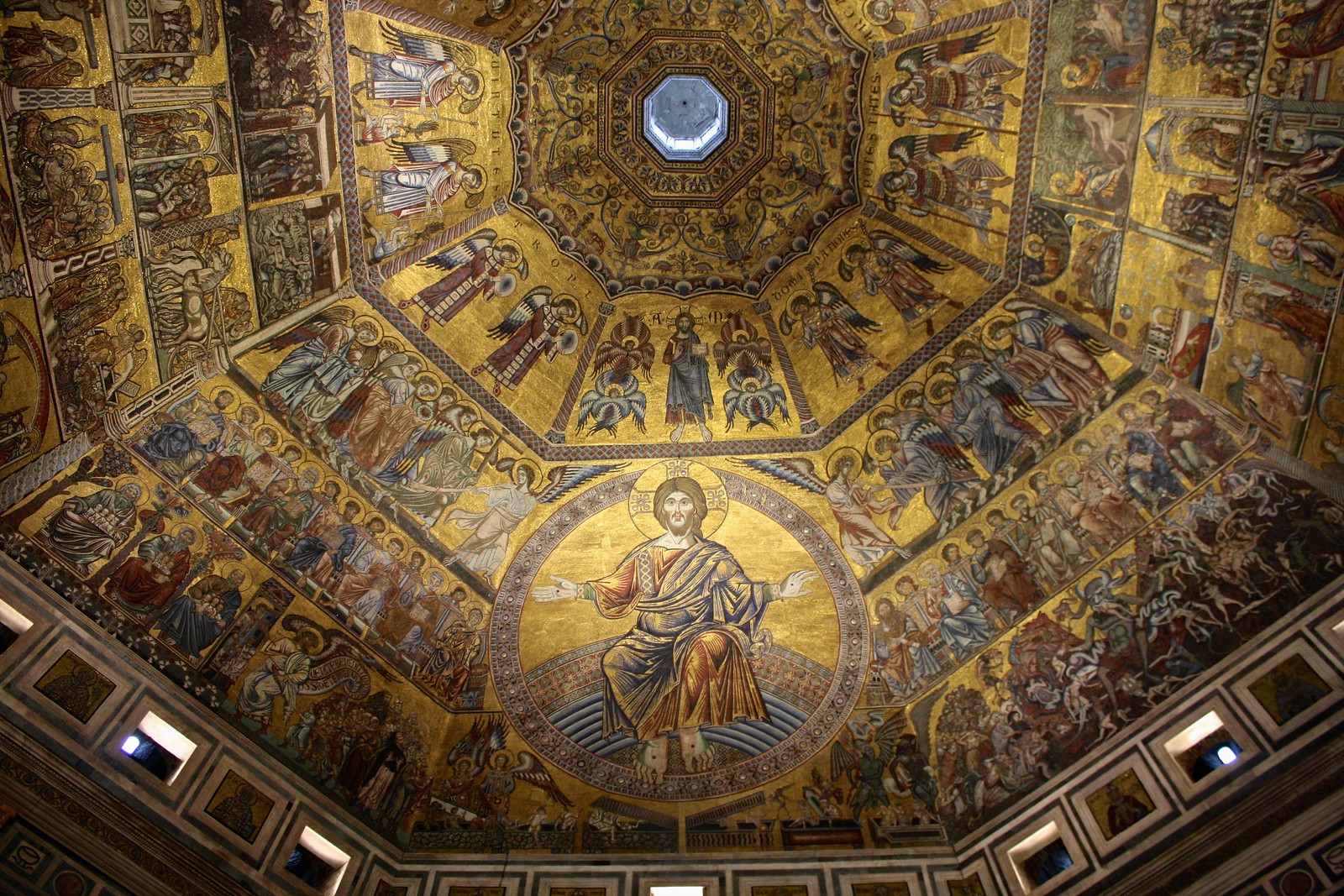 |
| Baptistery ceiling |
I was completely surprised by the freestanding baptistery, constructed when the Santa Separata church was still in use. This octagonal structure’s walls were built with handsome white and green marble laid into stripes and arches—a very Tuscan interpretation of the Romanesque style and very different from the simple, unadorned churches I’ve seen in Spain. The interior holds a jaw-dropping ceiling covered in gilded mosaics that tell stories from the Bible, with a Jesus in Judgment front and center.
The nearby museum was being renovated when I visited Florence, but I was still able to see the “Gates of Paradise” that originally opened to the baptistery’s north side. Designed by sculptor Ghiberti, the doors’ gilded bronze panels depicted biblical scenes with striking perspective and depth: the revolutionary Renaissance had arrived.
2) The urban setting
 |
| Arno River at dusk |
One of the first things I noticed when I arrived in Florence was the simple, yet beautiful, domestic architecture. Every road I turned down, I could expect to see sand-colored walls accented by green- or brown-painted shutters and dark gray stone around the doorway. Very classy and very Italian.
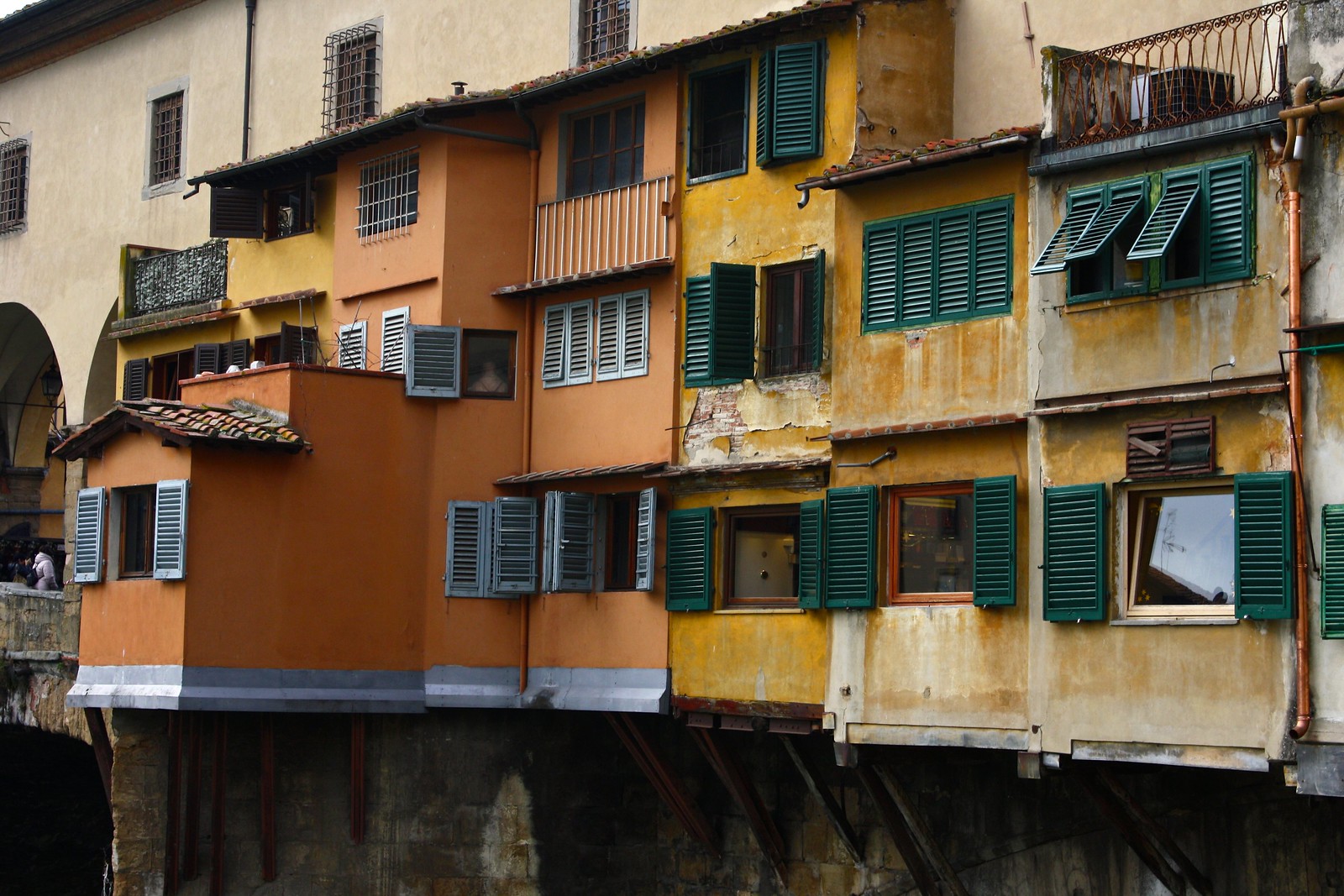 |
| Ponte Vecchio |
I got chills, though, when I strolled through the town’s ancient core (this may have been due to the wintry temperatures…). From one street to the next, I could stare down a perfectly-straight course that had endured since the town was the ancient Roman settlement of Florentia. It was eerie, y’all, especially when I made my way to the Piazza della Repubblica in the middle of the historic center. In Roman times it was Florence’s forum, and it’s still a major public square 2,000 years later.
3) The museums
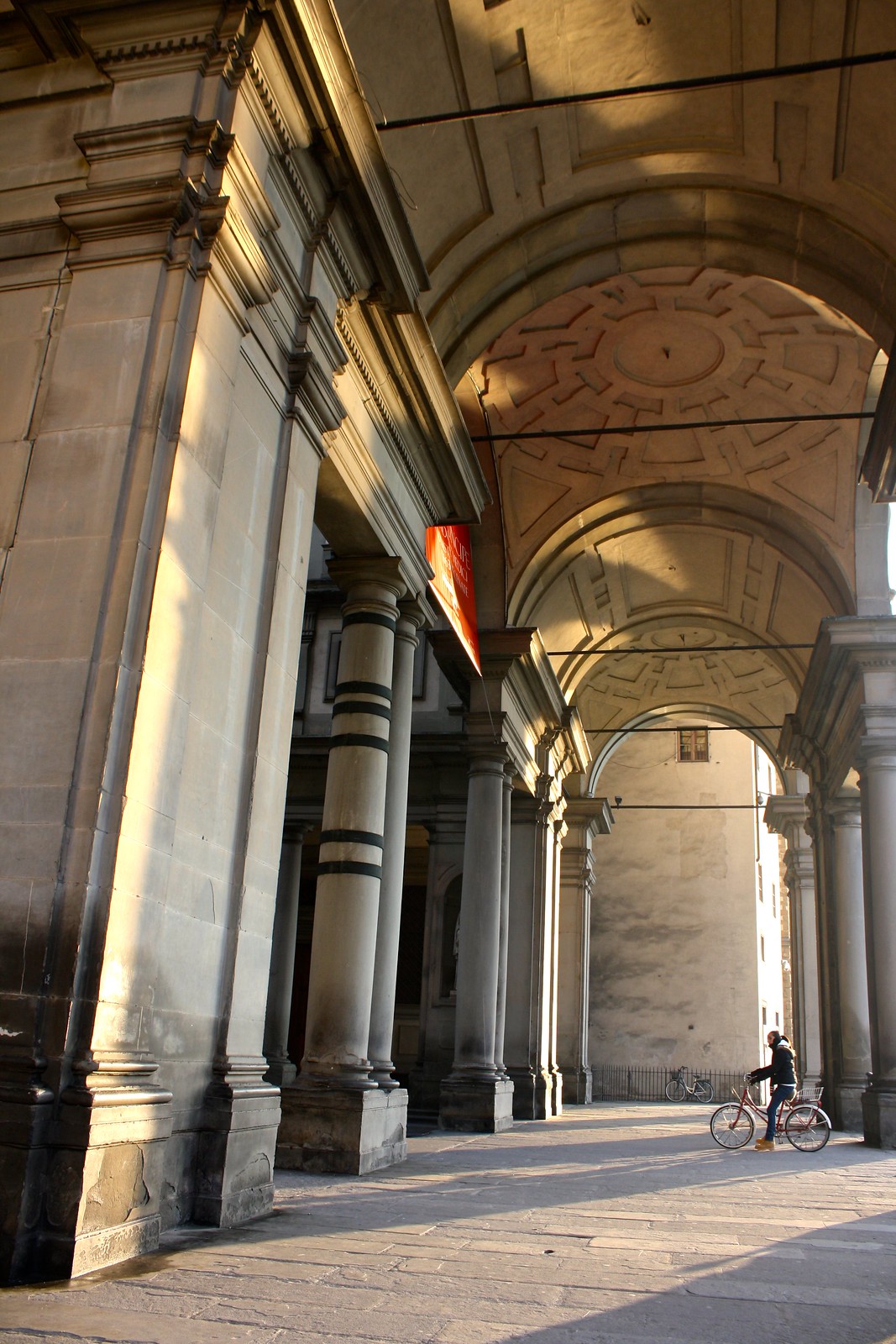 |
| Uffizi Gallery |
Although not nearly as visited or as vast as the Louvre in Paris, Florence’s riverside Uffizi Gallery still ranks as one of the most important art museums in Italy and Europe. Housed on a lavishly-decorated floor of the city’s old administrative offices (“uffizi” in Italian), the museum shows off paintings in its many halls and statues (mainly Roman) in the corridor. I loved getting to see in person famous works of art like Botticelli’s Allegory of Spring and Birth of Venus and Titian’s Venus of Urbino. And from railings in a doorway, I got to appreciate the lovely Greek marble statue called the Venus de’ Medici. I found the collection of Roman statues depicting Niobe and her daughters to be mind-blowingly lifelike and beautiful.
To the north of the old town sits the Accademia, a small, overpriced art museum whose star is Michelangelo’s glorious David statue. To me, the sculpture wasn’t nearly as titanic in size as documentaries and pictures have made it out to be, but it was still way larger than life and really showed off the humanistic ideals of the Renaissance. As you approach the statue you pass by some of Michelangelo’s unfinished works, his Prisoners, which give you an illuminating peek into his creative process.
 |
| Museum of Natural History a.k.a. “La Specola” |
Thanks to a post by Liz of Young Adventuress, I was tipped off to the weird, dated, and hardly-talked-out Museum of Natural History. Also called La Specola, it’s the world’s oldest natural history museum (since 1775) and holds a vast collection of stuffed mammals, birds, reptiles, fish, you name it. I spent a quarter of a hour just in the insect room, poring over displays that held beautiful moths, butterflies, and beetles. I laughed uncontrollably, however, when I came upon the infamous, poorly-taxidermied hippo, a former Medici family pet from the 1600s. La Specola was just down the street from the looming Pitti Palace and made for a fun, off-the-beaten-track, and nerdy way to spend part of an afternoon.
4) The churches
 |
| Church of Santa Maria Novella |
Architecture nerd that I am, I was really excited to visit Florence for all the great churches the city is home to. We’ve already discussed the cathedral above, so in this section, we’re moving on to, well, everything else.
Right by the train station of the same name, the Church of Santa Maria Novella (“New St. Mary’s”) is a grand, typically-Italian Gothic church with a playful green-and-white façade. The arcade that surrounds the adjoining cloisters, with its dozens of striped pointy arches, reminded me a lot of the Mosque-Cathedral of Córdoba, Spain. But the real reason I came here was to see The Holy Trinity, a revolutionary Renaissance fresco by Masaccio that pioneered the use of perspective and converging lines.
Another soaring example of Italian Gothic can be found on the other side of town: the Church of Santa Croce (“Holy Cross”). I was first inspired to check this place out after learning about the Pazzi Chapel, a later addition. Planned by Brunelleschi (same guy who designed the cathedral dome), it’s a perfect encapsulation of Renaissance architecture: a triumphal arch façade recalls ancient Rome, while inside, ideal forms like the circle and the square combine to create a simple, well-proportioned space. The interior of the actual church itself, however, really stunned me, because it’s the resting place of not only Galileo, but also Michelangelo, Dante, and Macchiavelli. Talk about a celebrity cemetery!
 |
| Pazzi Chapel, Church of Santa Croce |
The Church of San Lorenzo (“St. Lawrence”) is almost next door to the cathedral, and its attached Medici Chapels show off a miniature red-brick dome. But this church is Renaissance perfection, showing off semicircular arches, Corinthian columns, a nice dome, and a proportioned basilica plan. If you look up at the ceiling and count the square-shaped coffering, you’ll find that the transept and apse are 5x5 squares, whereas the length of the nave is exactly three times as long as one of these squares. I loved the contrast between the white plaster, dark stone, and gilded highlights. Although Michelangelo designed a façade for this church, it’s been left unfinished ever since Pope Leo X (a Medici) ran up the credit card in a war in Lombardy…oops.
Architect Brunelleschi worked on San Lorenzo as well as the similar Church of Santo Spirito (“Holy Spirit”) across the river in the Altrarno neighborhood. The interior is hard to distinguish from San Lorenzo’s: idealized semicircular arches with Corinthian columns, white plaster walls with dark pietra serena stone, and a pretty gilded ceiling. However, the chapels that line the walls in San Lorenzo are rectangular, whereas here they’re smooth and rounded; cubes or “dice” cap each column in Santo Spirito’s nave; and even though the exterior façade was also never finished, it’s been plastered over to create a simple, stately look.
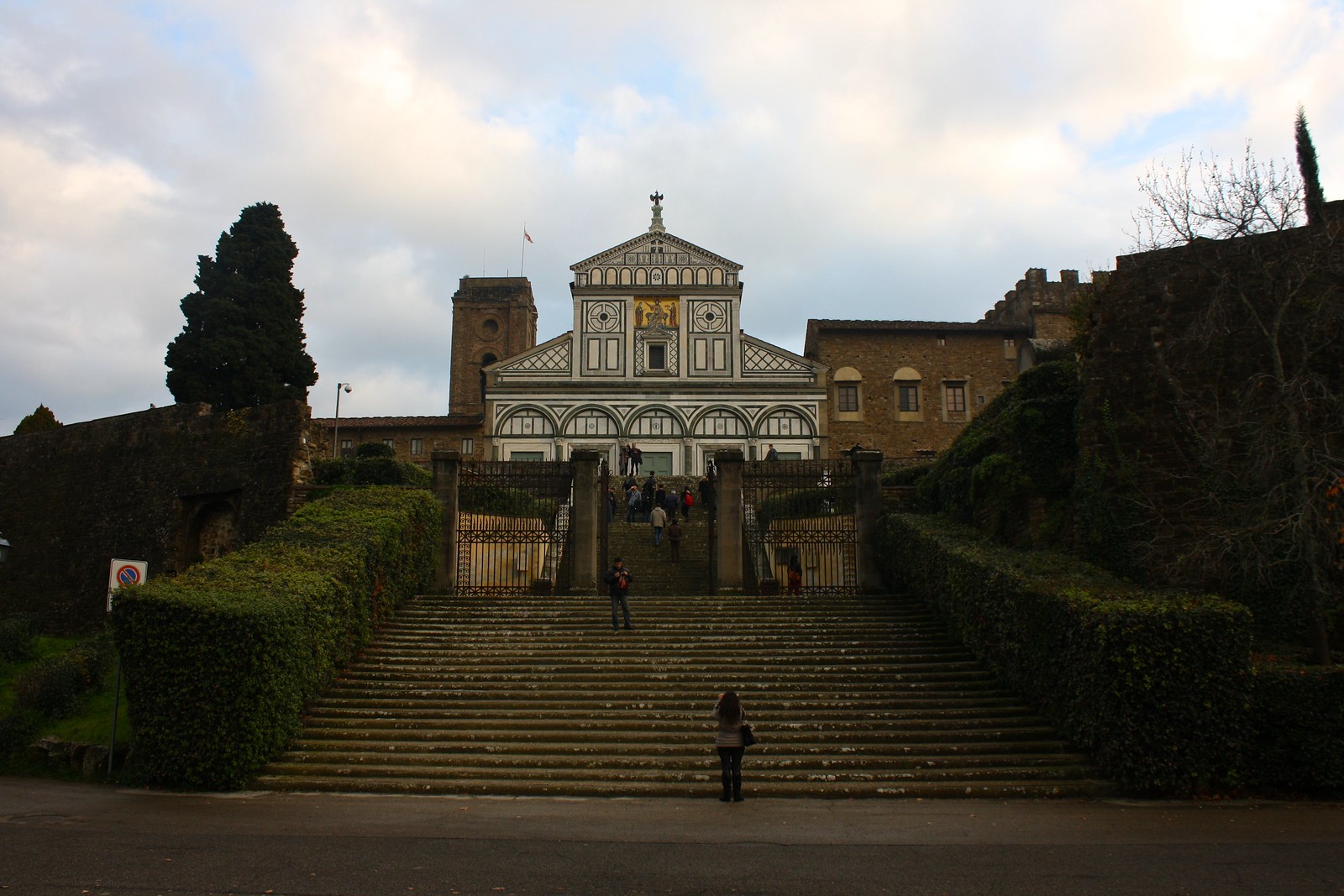 |
| Stairs, Church of San Miniato al Monte |
I finished my time in Florence at the Church of San Miniato al Monte, on the hill to the south of town. Inside and out, it’s a beautiful Romanesque gem that’s covered in geometric green and white marble. A painted wooden ceiling and golden mosaics in the apse round out the well-preserved church, which is home to the relics of St. Minias—an early Christian martyr who was beheaded and, according to legend, picked up his head, hiked up the mountain, and died where the church is today. Right after sunset, I got to attend a hauntingly beautiful vespers service done in Gregorian chant by the nearby monastic community.
5) The views
 |
| Florence, seen from the cathedral |
The views in Florence are some of the best in the world, and there’s several places you can climb up to enjoy them from. The most obvious lookout point is the cathedral’s dome, 463 steps, and the next-door bell tower (at 413 steps) offers similar views from a central location. Closer to the river, the Palazzo Vecchio’s clock tower—with 223 steps—gives you a grand look at the cathedral from afar as well as a peek across the river into the Altrarno. I loved trying to hunt down churches, palaces, streets, and train stations from up above, although it was a little tricky since it was mostly hazy and foggy the whole time I was here.
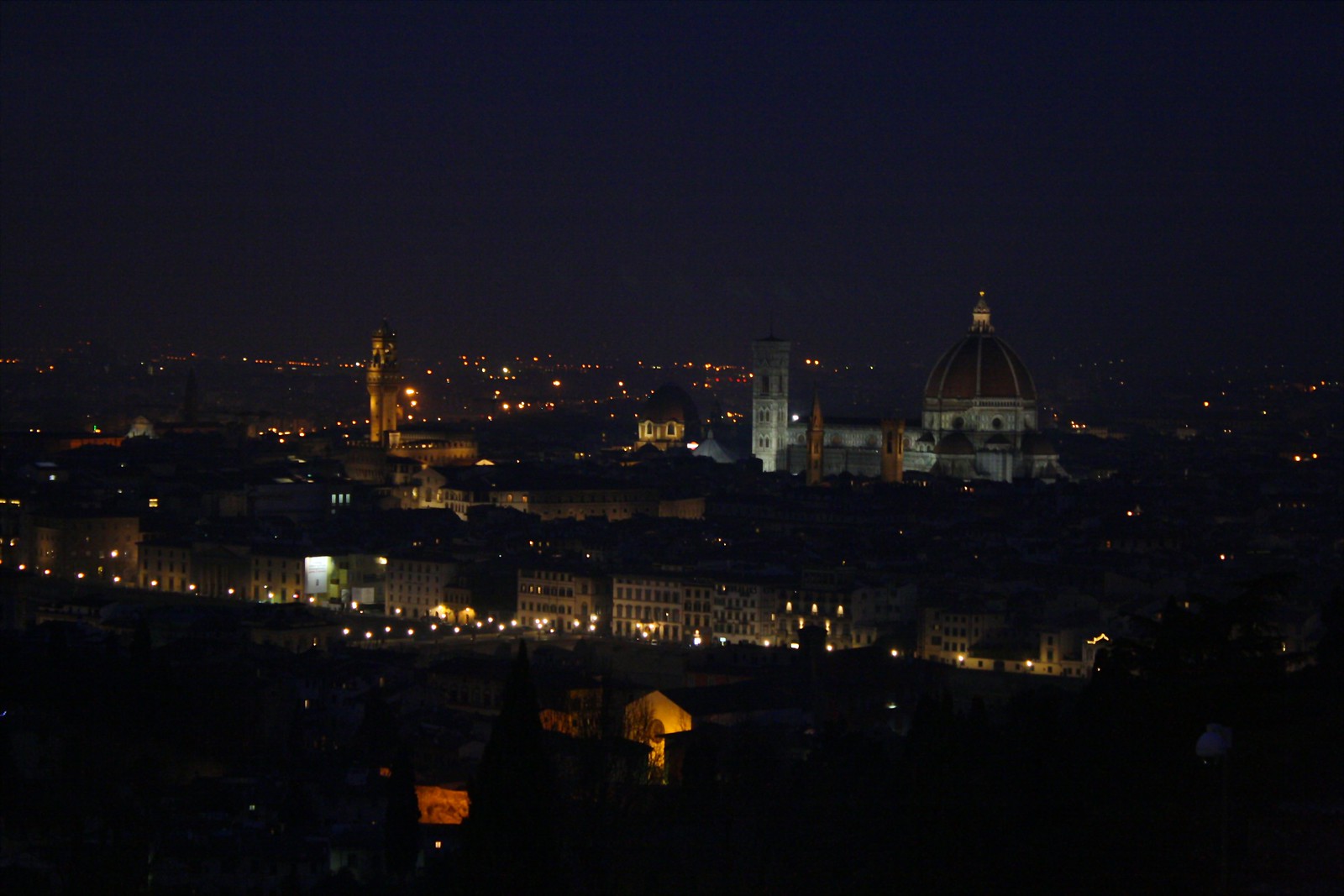 |
| Florence, seen from Monte di Firenze |
The best views of all came from the Monte di Firenze, south of the river. The Piazzale Michelangelo is a great place to get unobstructed views, pictures, selfies, etc. of the historic core, but you’ll have to watch out for annoying junk sellers, pickpockets, and other fellow tourists.
I preferred the vistas from a little higher up on “Mt. Florence” near the San Miniato church I talked about above. Not many people were hanging out in the small, quiet square in front of the church, so it was nice to watch the city change colors in peace as the sun set.
Have you been to Florence before? Did its beauty overwhelm you or did the hordes of tourists drown you? Is it okay to travel to super-touristy places or should you stick to undiscovered gems? Add your opinion in the comment section below.
